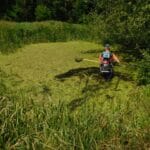Toenails are some of the most ignored body parts. If you are like most people, you hardly take the time to inspect your toenails, noting their color, shape, texture, and thickness. As a result, most people hardly notice a fungus growing in the nail until it is too late.
Toenail fungus is a common condition that afflicts many people. If you don’t catch it early, it becomes hard to treat. This article shares tips to detect nail fungus before it spreads. You will also learn some of the causes of nail fungus and how to treat the infection.
What Is Nail Fungus?
If you have ever seen anything moldy or used yeast to bake bread, you have interacted with a fungus. Yeast, mold, and rust on plants are examples of fungi that grow on different surfaces. A fungus is an organism that typically thrives in a wet and moist environment.
Nail fungus grows under the nail and can cause discomfort. Although nail fungus also affects fingernails, it is more prevalent in toenails. Your toenails spend most of their time in shoes, giving you less time to notice if anything is wrong with them. In contrast, you probably use your hand and fingers a lot, making it easy to note any change in your fingernails. Plus, your hands are less likely to spend as much time in gloves as your feet do in socks and shoes.
Symptoms of Nail Fungus
Some common symptoms of nail fungus include:
- Discolored nails
- Thickening of the nails
- Ragged, brittle, and crumbly nails
- Nails that begin to lose their shape
- Noticeable smelly feet
- Detached nails
If you notice these symptoms in your nails, the nail fungus infection is already at an advanced stage. Some people also report feeling some pain. Although the fungal infection is still curable at this stage, it takes a bit longer to clear. Therefore, it is best to catch it early.
How to Catch Nail Fungus Early
Catching the fungus infection early means you’ll be on medication for a shorter time. You’ll also save your nails from turning color and losing their beautiful shape.
One of the early signs of a nail fungus infection is the presence of an unusual yellow or brown streak or spot on the nail. However, don’t be alarmed when you see these discolored spots. Sometimes, they appear when you accidentally hurt your toes by knocking into furniture or kicking a ball.
Still, you can tell the difference between nail trauma and fungus infection by observing your nails. Nail trauma spots don’t increase in size. Instead, they’ll grow with the nail, and you end up removing them when you trim your nails. In contrast, fungus infection spots and streaks spread and begin to cover the whole surface of the nail.
Other early symptoms to watch out for include:
- Crumbling in areas where there’s discoloration, especially around the edges
- Flaking
- Slight changes in shape
- Foot odor
To catch these symptoms, make a habit of inspecting your nails regularly. A good time to do that is in the shower. Note if any spots occur, the texture of the nails, and any discoloration.
Causes of Nail Fungus
Nail fungus infection occurs when fungal organisms grow under your nails. You risk catching nail fungus when you walk barefoot in areas where fungi thrive. Such places include damp bathroom tiles and public changing rooms.
Another cause of nail fungus is wearing damp shoes. Some people wear their shoes before the inside dries well. That moisture combines with the heat your feet generate when you walk, creating an environment suitable for fungi to grow and thrive. Also, excessively sweaty feet make your shoes damp and prone to fungi infestation.
Additionally, various skin conditions can cause nail fungus. For instance, athlete’s foot may spread to your toenails and infect them. To prevent this condition, powder your feet before wearing your shoes.
A weak immunity makes your body prone to diseases. Therefore, you’re also likely to get nail fungus when your immunity is weakened. The fungus takes advantage of your body’s inability to fight it and grows unchecked. Underlying conditions such as diabetes also compromise your immunity, making you susceptible to nail fungus.
Preventing and Treating Nail Fungus
Removing a fungus from your nails can be a troublesome ordeal. Most fungi grow and spread fast, making them hard to battle.
Therefore, it’s better to try and prevent fungi from growing than to fight them once they’ve spread. The best way to do so is to avoid waking bare feet where fungi are likely to flourish. So the next time you’re in a public changing room, make it a point to wear slippers.
Also, avoid wearing shoes when your feet are wet. Dry them properly with a fan or towel so you don’t create an environment where fungi grow. An easy way to dry your covered footwear is by stuffing it with newspaper.
A final tip to prevent nail fungus is to observe hygiene. Keep your shoes and socks clean. Also, tidy up your environment and get rid of dampness that might support the growth of fungi.
If prevention measures fail and, unfortunately, you do get nail fungus, supplements help. Battling nail fungus needs you to be consistent with your supplement until the fungus stops growing and dies out.
Luckily, you don’t have to spend much time looking for an effective treatment. Simply get yourself the Fungus Eliminator from PureHealth Research. The product is ruthless against nail fungus but gentle on your toes and nails.
Conclusion
Most people keep their feet tucked in socks and shoes, which are perfect for fungus growth. Catching the nail fungus early before it spreads makes it easy to treat. Avoid walking barefoot in damp places and other areas where fungi are likely to grow. Inspect your nails regularly to check for signs of fungus infection. Check for discoloration, change in thickness, and brittleness. If you have nail fungus, use the Fungus Eliminator to clear the infection. Many customers swear by it!
Senior Outlook Today is your go-to source for information, inspiration, and connection as you navigate the later years of life. Our team of experts and writers is dedicated to providing relevant and engaging content for seniors, covering topics such as health and wellness, finances, technology and travel.





